The George Bush Presidential Library
 On my 34th birthday I spent some free time at the George Bush Presidential Library, which is located on the campus of Texas A&M University in College Station, TX. It is the seventh Presidential library and museum I've been to thus far (Hoover, FDR, Truman, Johnson, Nixon, and Reagan).
On my 34th birthday I spent some free time at the George Bush Presidential Library, which is located on the campus of Texas A&M University in College Station, TX. It is the seventh Presidential library and museum I've been to thus far (Hoover, FDR, Truman, Johnson, Nixon, and Reagan). I was warmly greeted by a volunteer, telling me what I could see inside. I don't believe any of the libraries I've been to do this.
I was warmly greeted by a volunteer, telling me what I could see inside. I don't believe any of the libraries I've been to do this. The lobby has the presidential seal in marble.
The lobby has the presidential seal in marble. The Bush legacy is subtly represented in the lobby, with the subject of the library being in the foreground.
The Bush legacy is subtly represented in the lobby, with the subject of the library being in the foreground. In one room, the signatures of various U.S. presidents are on display. It was interesting to note that only Ronald Reagan's had a slant to the left, signifying creativity over organization (although there are other graphology theories relating to a left slant).
In one room, the signatures of various U.S. presidents are on display. It was interesting to note that only Ronald Reagan's had a slant to the left, signifying creativity over organization (although there are other graphology theories relating to a left slant). The museum exhibit begins with a bust of George Herbert Walker Bush, the 41st President of the United States. Bush is described here as many things, ranging from a son to a president to a citizen.
The museum exhibit begins with a bust of George Herbert Walker Bush, the 41st President of the United States. Bush is described here as many things, ranging from a son to a president to a citizen.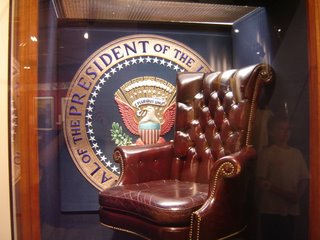 This was Bush's seat while serving as president.
This was Bush's seat while serving as president. Bush's father, Prescott, served in the U.S. Senate. He represented the state of Connecticut from 1953 to 1963. His son George would be born in Milton, Massachusetts, on June 12, 1924.
Bush's father, Prescott, served in the U.S. Senate. He represented the state of Connecticut from 1953 to 1963. His son George would be born in Milton, Massachusetts, on June 12, 1924. The former president always seemed to be a humble man, which is why it seem poignant to me that his family would get the first billing in his library.
The former president always seemed to be a humble man, which is why it seem poignant to me that his family would get the first billing in his library. Each one of Bush's children have photos on display.
Each one of Bush's children have photos on display. One photo of the larger clan, taken in Kennebunkport, ME in 2000, is also hung up.
One photo of the larger clan, taken in Kennebunkport, ME in 2000, is also hung up. The area of the museum seemed so warm and friendly, with a very interesting design. Right off the bat, I knew this was one of the better presidential libraries.
The area of the museum seemed so warm and friendly, with a very interesting design. Right off the bat, I knew this was one of the better presidential libraries. George H.W. Bush served in the U.S. Navy as a bomber pilot in World War II -- signing up on his 18th birthday -- and was shot down by Japanese forces at one point (due to his actions in completing his mission despite difficult odds, he was given the Distinguished Flying Cross). Here is the identification card he was given as an Ensign. At the Davenport, IA air show, I would see the kind of plane Bush piloted. Bush would fly in 58 combat missions during the war.
George H.W. Bush served in the U.S. Navy as a bomber pilot in World War II -- signing up on his 18th birthday -- and was shot down by Japanese forces at one point (due to his actions in completing his mission despite difficult odds, he was given the Distinguished Flying Cross). Here is the identification card he was given as an Ensign. At the Davenport, IA air show, I would see the kind of plane Bush piloted. Bush would fly in 58 combat missions during the war. Bush would marry Barbara Pierce on January 6, 1945 while still in the Navy. They would wed at First Presbyterian Church in Rye, NY.
Bush would marry Barbara Pierce on January 6, 1945 while still in the Navy. They would wed at First Presbyterian Church in Rye, NY. After the war, Bush would attend Yale University. He would serve as captain of the baseball and soccer teams, become president of his chapter of the Delta Kappa Epsilon fraternity, and join Phi Beta Kappa, the national honors society. While captain of his baseball team, he would meet the great Babe Ruth and play in the first College World Series.
After the war, Bush would attend Yale University. He would serve as captain of the baseball and soccer teams, become president of his chapter of the Delta Kappa Epsilon fraternity, and join Phi Beta Kappa, the national honors society. While captain of his baseball team, he would meet the great Babe Ruth and play in the first College World Series. After graduating college, Bush would drive to Texas and try to become an entrepreneur in the oil business.
After graduating college, Bush would drive to Texas and try to become an entrepreneur in the oil business. He would find himself in West Texas, living in Midland, TX where I once ate a really fantastic meal. It's also near the second largest meteor crater in America, located in Odessa, TX (lately, my life has been one big circle). He and others would create Zapata Oil which would have some moderate success.
He would find himself in West Texas, living in Midland, TX where I once ate a really fantastic meal. It's also near the second largest meteor crater in America, located in Odessa, TX (lately, my life has been one big circle). He and others would create Zapata Oil which would have some moderate success. In the coming years, the Bush family would grow. George and Barbara would have six children: George W. (the future president), Pauline Robinson ("Robin", who would die of leukemia at four years old), John (Jeb, who would become governor of Florida), Neil, Marvin, and Dorothy Walker.
In the coming years, the Bush family would grow. George and Barbara would have six children: George W. (the future president), Pauline Robinson ("Robin", who would die of leukemia at four years old), John (Jeb, who would become governor of Florida), Neil, Marvin, and Dorothy Walker. As a successful businessman, Bush would be asked to run the then non-existent local Republican party. In 1964, Bush ran for the U.S. Senate and lost in what was a heavily Democratic state in a year that GOP candidate Barry Goldwater was demolished by Lyndon Johnson.
As a successful businessman, Bush would be asked to run the then non-existent local Republican party. In 1964, Bush ran for the U.S. Senate and lost in what was a heavily Democratic state in a year that GOP candidate Barry Goldwater was demolished by Lyndon Johnson. Bush elected in 1966 and 1968 to the House of Representatives from the 7th District of Texas, serving on the important House Ways and Means committee. In 1970, future Secretary of State James A. Baker would manage Bush's second campaign for the United States Senate, in which he would lose to Democrat (and future Vice Presidential candidate against him) Lloyd Bentsen.
Bush elected in 1966 and 1968 to the House of Representatives from the 7th District of Texas, serving on the important House Ways and Means committee. In 1970, future Secretary of State James A. Baker would manage Bush's second campaign for the United States Senate, in which he would lose to Democrat (and future Vice Presidential candidate against him) Lloyd Bentsen. In 1971, President Nixon would appoint Bush to be the Ambassador to the United Nations, a cabinet-level post.
In 1971, President Nixon would appoint Bush to be the Ambassador to the United Nations, a cabinet-level post. In this role, Bush would develop the skills and experience that would make him a strong advocate for American interests overseas. He'd also get some good use out of his passport.
In this role, Bush would develop the skills and experience that would make him a strong advocate for American interests overseas. He'd also get some good use out of his passport. After Nixon was re-elected, Bush was asked to chair the Republican National Committee. It would turn out to be a very tough assignment for the future President, as Nixon would resign in disgrace over the Watergate affair.
After Nixon was re-elected, Bush was asked to chair the Republican National Committee. It would turn out to be a very tough assignment for the future President, as Nixon would resign in disgrace over the Watergate affair. The new President Ford considered Bush for the office of Vice President, but went with New York Governor Nelson Rockefeller instead. Bush would be asked to be Chief of the U.S. Liaison office to China.
The new President Ford considered Bush for the office of Vice President, but went with New York Governor Nelson Rockefeller instead. Bush would be asked to be Chief of the U.S. Liaison office to China. Soon after, on November 1, 1975, President Ford asked Bush to become the director of Central Intelligence.
Soon after, on November 1, 1975, President Ford asked Bush to become the director of Central Intelligence. His briefcase, which held the greatest secrets our country had at the time, is on display.
His briefcase, which held the greatest secrets our country had at the time, is on display.
There, he would earn the National Intelligence Distinguished Service medal. Despite his honors, however, politics would ensure that Bush would not hold the post for very long.
 Then Republican President Ford would struggle hard against Democrat Jimmy Carter for re-election, but would lose much of the East and all of the South in an unsuccessful bid. With a Democrat in office as president, Bush would go on to work in the private sector.
Then Republican President Ford would struggle hard against Democrat Jimmy Carter for re-election, but would lose much of the East and all of the South in an unsuccessful bid. With a Democrat in office as president, Bush would go on to work in the private sector. To many people's surprise, George H.W. Bush would announce his candidacy for President on May 1st, 1979 (my father's birthday). Bush would do much better than most people expected (and as the museum failed to note, at this time he coined the phrase "voodoo economics" that would plague President Reagan during his tenure). Bush would achieve an upset victory in Iowa, but it would be Reagan's year.
To many people's surprise, George H.W. Bush would announce his candidacy for President on May 1st, 1979 (my father's birthday). Bush would do much better than most people expected (and as the museum failed to note, at this time he coined the phrase "voodoo economics" that would plague President Reagan during his tenure). Bush would achieve an upset victory in Iowa, but it would be Reagan's year.His campaign caught Reagan's attention, and leading up to the Republican convention he would call then Ambassador Bush and say:
"Hello George, this is Ron Reagan. I'd like to go over to the convention and announce that you're my choice for vice president...if that's alright with you."The life of George H.W. Bush would never be the same.
 The Reagan/Bush ticket would win two national landslide elections. In 1984, the team would win more electoral votes than any other in American history.
The Reagan/Bush ticket would win two national landslide elections. In 1984, the team would win more electoral votes than any other in American history. Soon after becoming Vice President, Ronald Reagan was shot. Bush was faced with the possibility of immediately being sworn in as the next President of the United States. While on Air Force Two going back to the White House, Bush would write on Air Force Stationary the thoughts on his mind. They included:
Soon after becoming Vice President, Ronald Reagan was shot. Bush was faced with the possibility of immediately being sworn in as the next President of the United States. While on Air Force Two going back to the White House, Bush would write on Air Force Stationary the thoughts on his mind. They included:1. Enormity of it comes upon me. 20 minutes out of Austin.Bush would discuss these comments, and others he wrote on this paper, with CBS News years later. They show the high character of a man in a very tense situation.
2. Pray -- literally -- that R.R. recovers.
3. Element a friend, not just C. in C., President. Decent, warm, kind.
4. Not knowing.
5. Not fly -- intentionally, into S. Lawn.
 George Bush would run for President in 1988 and choice Indiana's junior senator, Dan Quayle, as his running mate.
George Bush would run for President in 1988 and choice Indiana's junior senator, Dan Quayle, as his running mate. Campaigning on a theme of a "kinder and gentler nation," they would win and Bush would become our nation's 41st president.
Campaigning on a theme of a "kinder and gentler nation," they would win and Bush would become our nation's 41st president. The museum covers his time in the White House in some depth.
The museum covers his time in the White House in some depth. The President would be the last to serve under the Cold War. A piece of the Berlin wall is on display, appropriately enough, at the library of the American leader who was in office when it was brought down.
The President would be the last to serve under the Cold War. A piece of the Berlin wall is on display, appropriately enough, at the library of the American leader who was in office when it was brought down. The era, from just after World War II until the early 90s is discussed using words, declassified documents, and photos.
The era, from just after World War II until the early 90s is discussed using words, declassified documents, and photos. Documents on display, including comments from then German Chancellor Helmut Kohl, praise Bush's leadership and his place in the reunification of Germany.
Documents on display, including comments from then German Chancellor Helmut Kohl, praise Bush's leadership and his place in the reunification of Germany. Bush's domestic agenda, an area where history does not often laud him in, is described in one section. They include the Americans with Disabilities Act (you can always tell a post-Bush-era elevator by it's large buttons located lower than most people would want them), the Clean Air Act (that is praised in Al Gore's "Inconvenient Truth" movie), other pro-environment moves, and the successful negotiation of NAFTA, the North American Free Trade Agreement, that President Bill Clinton would put through Congress.
Bush's domestic agenda, an area where history does not often laud him in, is described in one section. They include the Americans with Disabilities Act (you can always tell a post-Bush-era elevator by it's large buttons located lower than most people would want them), the Clean Air Act (that is praised in Al Gore's "Inconvenient Truth" movie), other pro-environment moves, and the successful negotiation of NAFTA, the North American Free Trade Agreement, that President Bill Clinton would put through Congress. One section shows gifts from foreign governments.
One section shows gifts from foreign governments.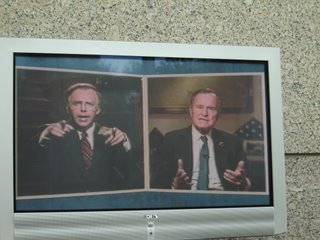 Here, Bush shows his personal side and humor. Some of the former President's funnier moments, including this Saturday Night Live skit with his imitator Dana Carvey, are shown to museum visitors.
Here, Bush shows his personal side and humor. Some of the former President's funnier moments, including this Saturday Night Live skit with his imitator Dana Carvey, are shown to museum visitors.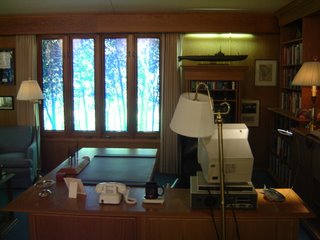 Like Herbert Hoover's Library, this one does not have a replica of the Oval Office. Instead, Bush's office at Camp David, his retreat center, is on display.
Like Herbert Hoover's Library, this one does not have a replica of the Oval Office. Instead, Bush's office at Camp David, his retreat center, is on display. Also shown is a replica of Bush's Air Force One office. You may recall, from this blog, that the actual plane used by Ronald Reagan is in his library.
Also shown is a replica of Bush's Air Force One office. You may recall, from this blog, that the actual plane used by Ronald Reagan is in his library. While Americans give #41 little credit on domestic affairs, he was known as a very skillful participant in foreign affairs. Then Canadian Prime Minister Brian Mulroney would say, "when George Bush was President of the United States, every single head of government in the world knew they were dealing with a genuine leader."
While Americans give #41 little credit on domestic affairs, he was known as a very skillful participant in foreign affairs. Then Canadian Prime Minister Brian Mulroney would say, "when George Bush was President of the United States, every single head of government in the world knew they were dealing with a genuine leader."Bush would call on the personal relationships cultivated in the past for his foreign affairs work. For instance, President Bush would be the first foreign leader to call Nelson Mandela when he was released from prison. On a tougher note, Bush sent American troops into Panama to overthrow Panamanian leader General Manuel Noriega. Noriega was brought to the United States for trial as a drug trafficker.
 Bush would also show respect to his predecessors, allowing them to receive regular updates on intelligence and national security matters.
Bush would also show respect to his predecessors, allowing them to receive regular updates on intelligence and national security matters. Bush's greatest accomplishment was undoubtedly his leadership during the Gulf War, when America's faith in its military might was restored. Bush helped put together an impressive military coalition that included a wide variety of nations and religious affiliations, along with 425,000 American troops.
Bush's greatest accomplishment was undoubtedly his leadership during the Gulf War, when America's faith in its military might was restored. Bush helped put together an impressive military coalition that included a wide variety of nations and religious affiliations, along with 425,000 American troops.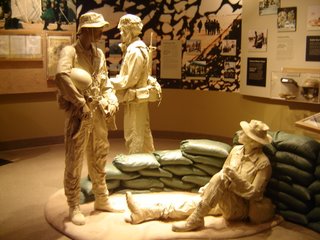 The Gulf War is given a lot of attention in the museum. It was his greatest realization of his vision of a "New World Order" of international law and global consensus.
The Gulf War is given a lot of attention in the museum. It was his greatest realization of his vision of a "New World Order" of international law and global consensus. This helmet, worn by Lt. Michael A. Kelley, has a Texas A&M Aggie logo painted on his helmet.
This helmet, worn by Lt. Michael A. Kelley, has a Texas A&M Aggie logo painted on his helmet. In a fitting display of the gratitude of the nation of Kuwait, and the sacrifice made by U.S. soldiers, engraved in a "Gate of Kuwait" are the names of U.S. military personnel who died in the war.
In a fitting display of the gratitude of the nation of Kuwait, and the sacrifice made by U.S. soldiers, engraved in a "Gate of Kuwait" are the names of U.S. military personnel who died in the war. The Gulf War and Bush's foreign policy would not be enough for the President to win re-election. The museum points out that a recession from 1991 to early 1992 led to corporate layoffs and a nervous American public. The recession would be over and economic growth would hit 4.3 percent on election day, but not enough people believed it. Bill Clinton would win 43 percent of the vote and become president of the United States. The library does not mention Bush's campaign promise of "read my lips, no new taxes" and his 1990 compromise with Democrats to break it.
The Gulf War and Bush's foreign policy would not be enough for the President to win re-election. The museum points out that a recession from 1991 to early 1992 led to corporate layoffs and a nervous American public. The recession would be over and economic growth would hit 4.3 percent on election day, but not enough people believed it. Bill Clinton would win 43 percent of the vote and become president of the United States. The library does not mention Bush's campaign promise of "read my lips, no new taxes" and his 1990 compromise with Democrats to break it. Just outside the library is "The Day The Wall Came Down," by Veryl Goodnight, which is inspired by the fall of the Berlin Wall.
Just outside the library is "The Day The Wall Came Down," by Veryl Goodnight, which is inspired by the fall of the Berlin Wall. Nearby, the future gravesite of the former President and First Lady sits.
Nearby, the future gravesite of the former President and First Lady sits. The only actual grave at the site currently belongs to Robin Bush, the current President's sister, who died at an early age.
The only actual grave at the site currently belongs to Robin Bush, the current President's sister, who died at an early age.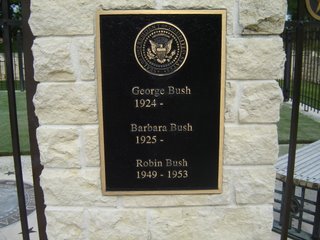 However, the sign is there and it appears it's only a matter of time until the Bush family rests here.
However, the sign is there and it appears it's only a matter of time until the Bush family rests here. It is a fantastic library, and is up there with the LBJ museum in Austin, TX. It's only seven dollars, just one more than Herbert Hoover's. This one is a lot better. If you're in Aggieland, do check it out.
It is a fantastic library, and is up there with the LBJ museum in Austin, TX. It's only seven dollars, just one more than Herbert Hoover's. This one is a lot better. If you're in Aggieland, do check it out.RELATED LINKS:
President George H.W. Bush's offical White House biography.
The Wikipedia biography of George H.W. Bush
Wikipedia: George Bush Library



0 Comments:
Post a Comment
|<< Home